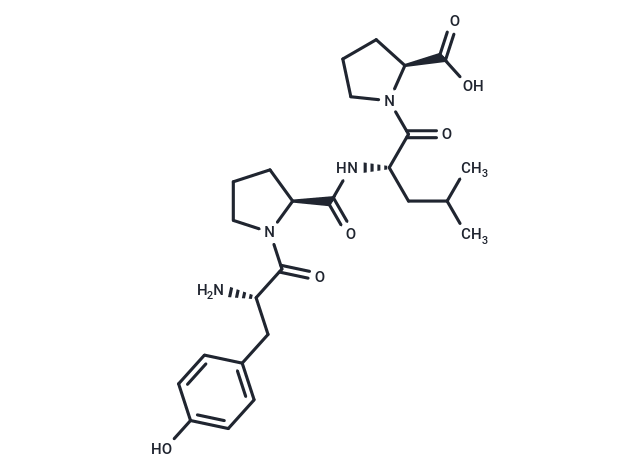Shopping Cart
- Remove All
 Your shopping cart is currently empty
Your shopping cart is currently empty

YPLP, a yeast-derived peptide Tyr-Pro-Leu-Pro, demonstrates anti-fatigue activity via the nuclear factor erythroid-2-related factor 2 (Nrf2) and AMP-activated protein kinase (AMPK) pathways. YPLP is orally active [1].

| Pack Size | Price | Availability | Quantity |
|---|---|---|---|
| 10 mg | Inquiry | Inquiry | |
| 50 mg | Inquiry | Inquiry |
| Description | YPLP, a yeast-derived peptide Tyr-Pro-Leu-Pro, demonstrates anti-fatigue activity via the nuclear factor erythroid-2-related factor 2 (Nrf2) and AMP-activated protein kinase (AMPK) pathways. YPLP is orally active [1]. |
| In vivo | YPLP, administered at 10-50 mg/kg via gavage for four weeks, reduces oxidative damage in ICR mice induced by exercise by decreasing lipid peroxidation and enhancing antioxidant enzyme activity through the Nrf2/Keap1 pathway. It improves ATP levels and energy metabolism in fatigued ICR mice via AMPK phosphorylation and increased AMPK protein levels. Furthermore, YPLP regulates muscle function in fatigued mice by modulating the expression of differentially abundant proteins (DAP) involved in protein synthesis/degradation, muscle dynamics, and nuclear transport. Animal Model: ICR mice [1] Dosage: 10-50 mg/kg/d Administration: i.g. for 4 weeks Result: Increased levels of Nrf2, ATP, pAMPK and decreased levels of Keap1. |
| Molecular Weight | 488.58 |
| Formula | C25H36N4O6 |
| Cas No. | 2414391-44-7 |
| Storage | Powder: -20°C for 3 years | In solvent: -80°C for 1 year | Shipping with blue ice. |

Copyright © 2015-2025 TargetMol Chemicals Inc. All Rights Reserved.